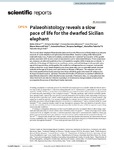Palaeohistology Reveals a Slow Pace of Life for the Dwarfed Sicilian Elephant

Use este enlace para citar
http://hdl.handle.net/2183/29980
A non ser que se indique outra cousa, a licenza do ítem descríbese como Atribución 4.0 Internacional
Coleccións
- Investigación (FCIE) [1260]
Metadatos
Mostrar o rexistro completo do ítemTítulo
Palaeohistology Reveals a Slow Pace of Life for the Dwarfed Sicilian ElephantAutor(es)
Data
2021-11-24Cita bibliográfica
Köhler, M., Herridge, V., Nacarino-Meneses, C. et al. Palaeohistology reveals a slow pace of life for the dwarfed Sicilian elephant. Sci Rep 11, 22862 (2021). https://doi.org/10.1038/s41598-021-02192-4
Resumo
[Abstract] The 1-m-tall dwarf elephant Palaeoloxodon falconeri from the Pleistocene of Sicily (Italy) is an extreme example of insular dwarfism and epitomizes the Island Rule. Based on scaling of life-history (LH) traits with body mass, P. falconeri is widely considered to be ‘r-selected’ by truncation of the growth period, associated with an early onset of reproduction and an abbreviated lifespan. These conjectures are, however, at odds with predictions from LH models for adaptive shifts in body size on islands. To settle the LH strategy of P. falconeri, we used bone, molar, and tusk histology to infer growth rates, age at first reproduction, and longevity. Our results from all approaches are congruent and provide evidence that the insular dwarf elephant grew at very slow rates over an extended period; attained maturity at the age of 15 years; and had a minimum lifespan of 68 years. This surpasses not only the values predicted from body mass but even those of both its giant sister taxon (P. antiquus) and its large mainland cousin (L. africana). The suite of LH traits of P. falconeri is consistent with the LH data hitherto inferred for other dwarfed insular mammals. P. falconeri, thus, not only epitomizes the Island Rule but it can also be viewed as a paradigm of evolutionary change towards a slow LH that accompanies the process of dwarfing in insular mammals.
Versión do editor
Dereitos
Atribución 4.0 Internacional
ISSN
2045-2322






